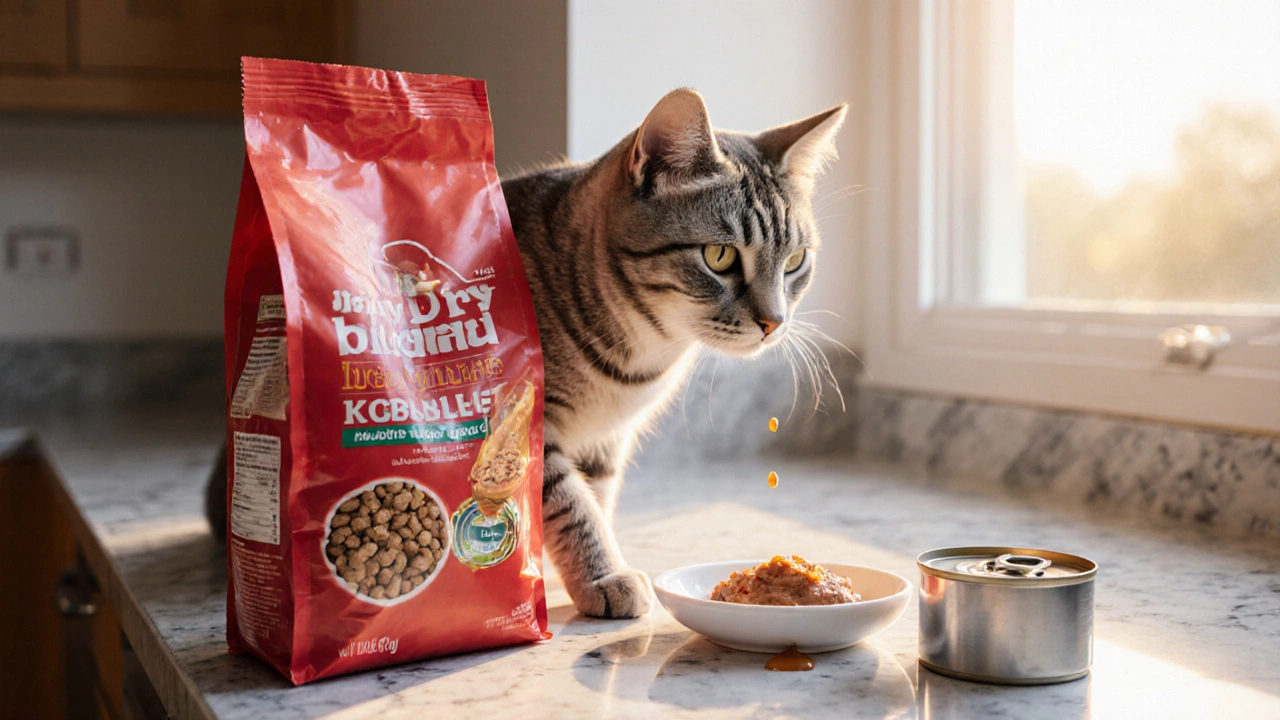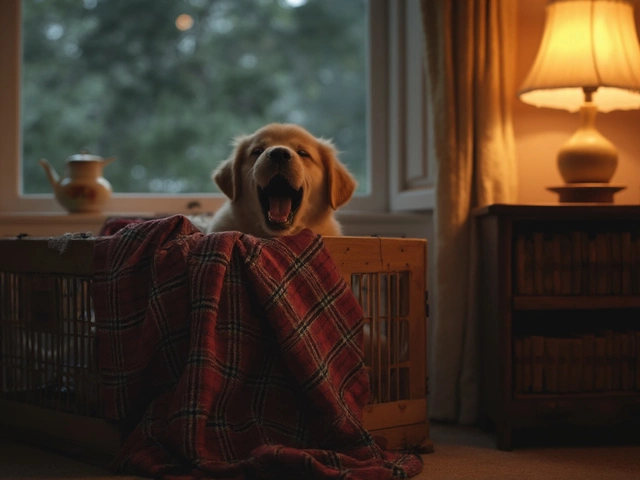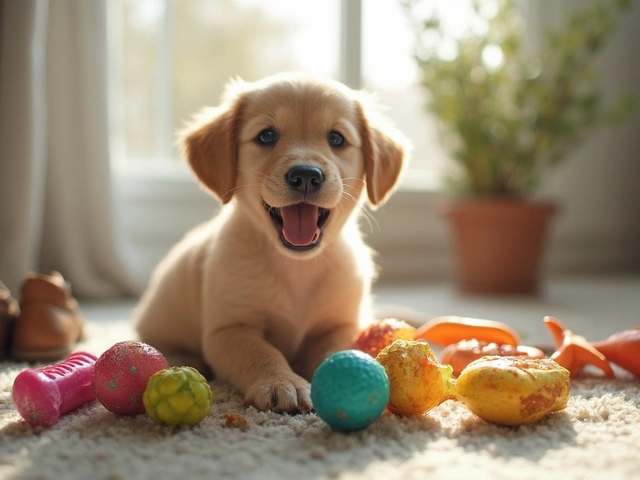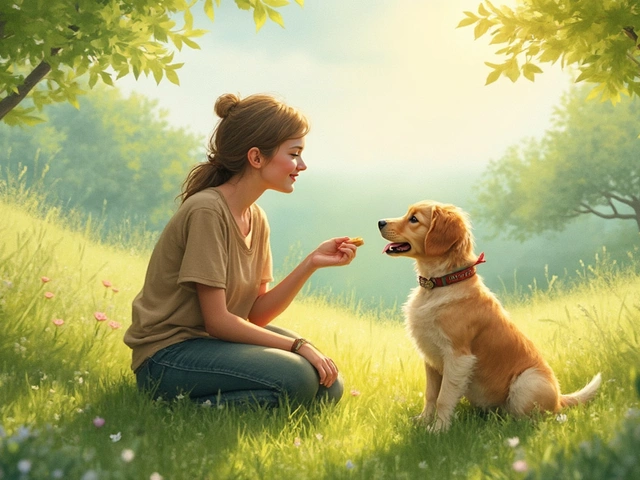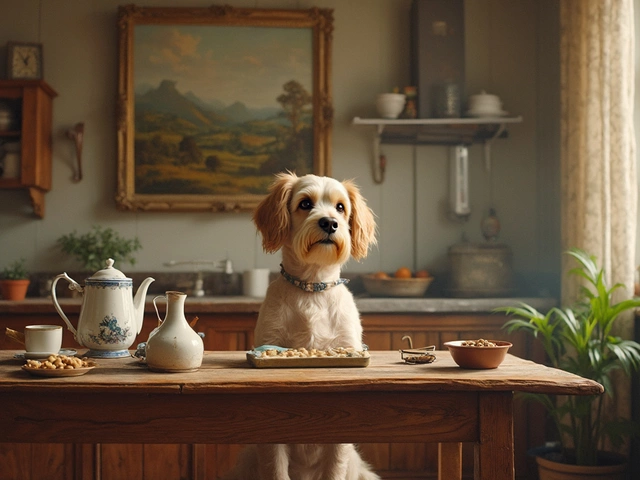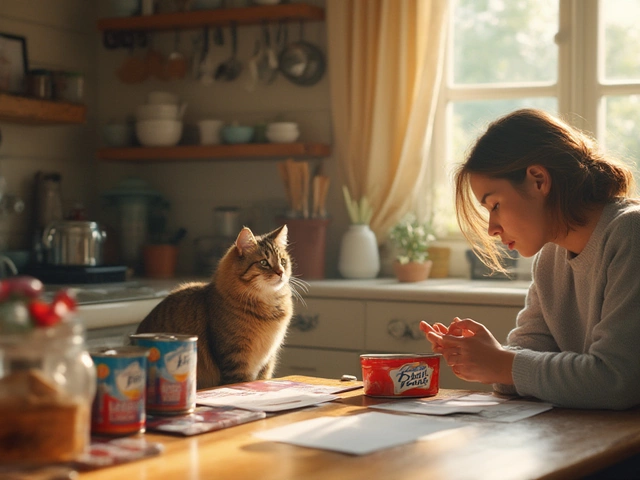Cat Food Calculator
Daily Cat Nutrition Calculator
Find the optimal balance of wet and dry food for your cat based on weight, age, activity level, and health needs.
Daily Nutrition Plan
RecommendedTip: Always consult with your veterinarian before making major diet changes.
Key Takeaways
- Wet food provides superior hydration, which helps prevent urinary and kidney issues.
- Dry kibble is calorie‑dense and convenient, but can contribute to obesity if over‑served.
- Both formats can meet a cat's protein and taurine needs when you read labels carefully.
- Mixing wet and dry offers the best of both worlds for most healthy cats.
- Tailor the ratio to your cat's age, activity level, and any medical conditions.
Ever stared at a bag of kibble and a can of pâté, wondering which one will keep Whiskers thriving? The debate between dry cat food and wet cat food isn’t just about price or convenience-it’s about the long‑term wellbeing of your pet. Below we break down the science, the practical pros and cons, and a step‑by‑step plan to build a truly healthy cat diet that fits your lifestyle.
Understanding Feline Nutrition Basics
Domestic cats are obligate carnivores, meaning they rely on animal‑derived protein for survival. Key nutrients include:
- Protein - essential for muscle maintenance and growth.
- Taurine - an amino acid cats cannot synthesize in adequate amounts; deficiency leads to heart and vision problems.
- Moisture - crucial for kidney function and urinary tract health.
- Vitamins A, D, and B‑complex, as well as fatty acids like EPA and DHA.
When you compare dry and wet foods, the first three nutrients-protein, taurine, and moisture-become the most telling differences.
What Is Dry Cat Food?
Dry cat food is a dehydrated kibble that typically contains 8‑12% moisture. The low water content means the kibble is lightweight, shelf‑stable, and easy to portion.
Manufacturers achieve the crunchy texture by extrusion, a high‑temperature process that can slightly denature proteins but also improves digestibility for many cats. Because it’s energy‑dense, a small handful can deliver a full day's calories.
Advantages of dry food include:
- Convenient storage and no refrigeration required.
- Chewing action helps reduce plaque buildup on teeth.
- Often cheaper per calorie than canned options.
Potential downsides:
- Low moisture can exacerbate dehydration, especially in older cats or those with kidney disease.
- Higher carbohydrate levels may contribute to weight gain if not monitored.
- Some cats simply find the texture less palatable.
What Is Wet (Canned) Cat Food?
Wet cat food is a moisture‑rich product, usually 70‑80% water, packed in tins, pouches, or trays. It is cooked at lower temperatures than dry kibble, preserving more natural animal proteins and fats.
Because of its high water content, wet food mimics the prey that wild cats would hunt-muscle, organs, and blood-offering a more biologically appropriate nutrient profile.
Key benefits:
- Excellent hydration support, reducing the risk of urinary crystals and kidney strain.
- Typically higher protein percentages and lower carbs.
- Often more aromatic, making it appealing to picky eaters.
Challenges include:
- Requires refrigeration after opening.
- Higher cost per serving.
- Less dental benefit; the soft texture doesn’t clean teeth.
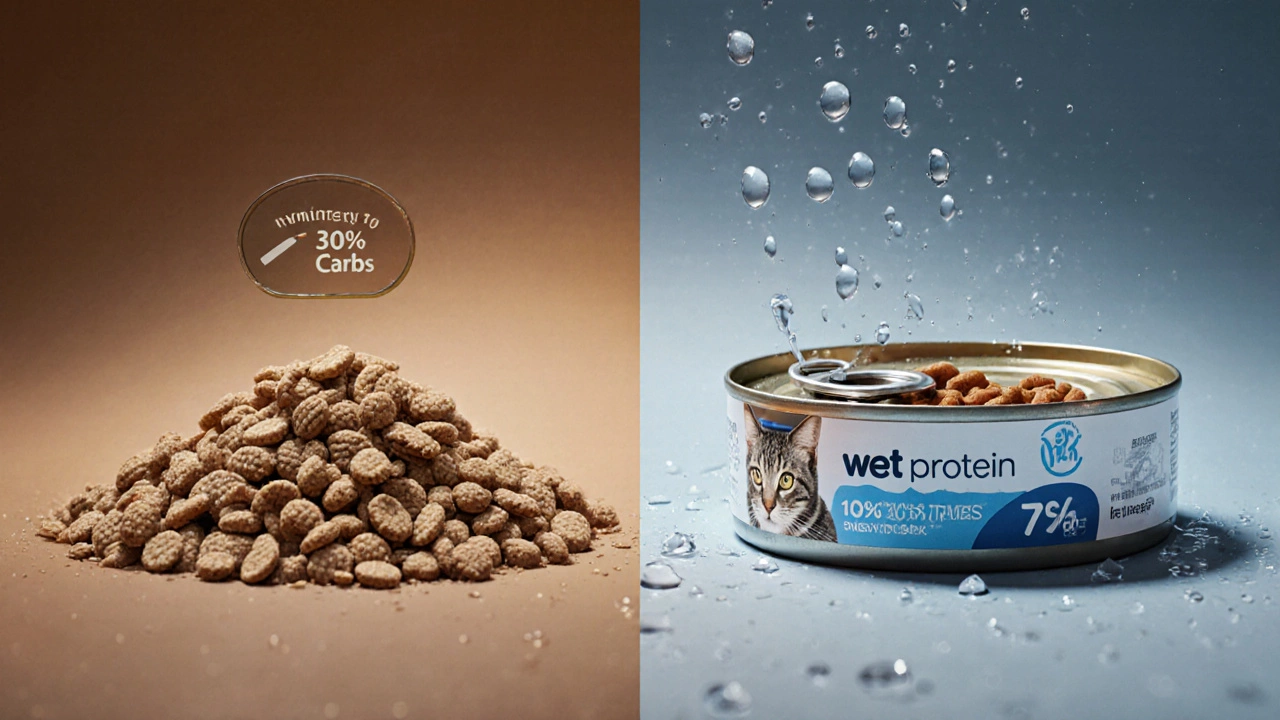
Side‑by‑Side Comparison
| Attribute | Dry Food | Wet Food |
|---|---|---|
| Moisture % | 8‑12% | 70‑80% |
| Calories (kcal) per 100g | 350‑400 | 70‑120 |
| Protein % (minimum) | 30‑35% | 45‑55% |
| Carbohydrate % | 30‑40% | 5‑15% |
| Cost per day (USD) | $0.30‑$0.60 | $0.70‑$1.20 |
| Dental benefit | Yes - abrasive texture | No - soft texture |
| Hydration support | Low - relies on water bowl | High - provides ~70% of daily water |
| Shelf life (unopened) | 12‑24 months | 12‑18 months (canned) |
How to Choose the Right Balance for Your Cat
There’s no one‑size‑fits‑all answer. Instead, think of your cat’s profile as a set of variables:
- Age - Kittens need more calories and protein; seniors benefit from extra moisture.
- Activity level - Indoor, couch‑potato cats need fewer calories than outdoor hunters.
- Health conditions - Kidney disease, urinary tract issues, or obesity each call for specific adjustments.
- Preference - Some cats will reject a texture outright; never force a food they despise.
Based on these factors, follow these steps:
- Consult your veterinarian for any medical restrictions.
- Start with a 70/30 mix favoring wet food if your cat drinks little water.
- Monitor weight weekly for the first month; adjust portions accordingly.
- Gradually introduce dry kibble to improve dental health, aiming for a final ratio of 50/50 if weight stays stable.
- Re‑evaluate every six months or after major life changes (e.g., moving, new pet).
Practical Feeding Tips
Even the perfect nutrition plan can fall apart without good habits:
- Measure every meal. Use a kitchen scale or the scoop provided by the brand to avoid “free‑feeding” excess calories.
- Provide fresh water. A water fountain encourages cats to drink more, especially when feeding dry kibble.
- Rotate flavors. Switching between chicken, fish, and turkey reduces the risk of nutrient gaps and keeps meals interesting.
- Store properly. Keep dry bags sealed; refrigerate opened cans within two hours and discard leftovers after 24hours.
- Watch the litter box. Changes in urine color, frequency, or odor can signal dehydration or urinary issues.
Common Pitfalls and How to Avoid Them
Many cat owners fall into these traps without realizing the impact:
| Mistake | Why It Hurts | Correction |
|---|---|---|
| Only feeding dry kibble | Low moisture → dehydration, urinary crystals | Add at least one wet meal per day |
| Free‑feeding | Uncontrolled calorie intake → obesity | Schedule measured meals 2-3 times daily |
| Choosing low‑price brands without label checks | May lack adequate taurine or have filler carbs | Read guaranteed analysis; aim for ≥30% protein, ≥0.1% taurine |
| Switching diets abruptly | Digestive upset, diarrhea | Mix old and new foods gradually over 7‑10 days |
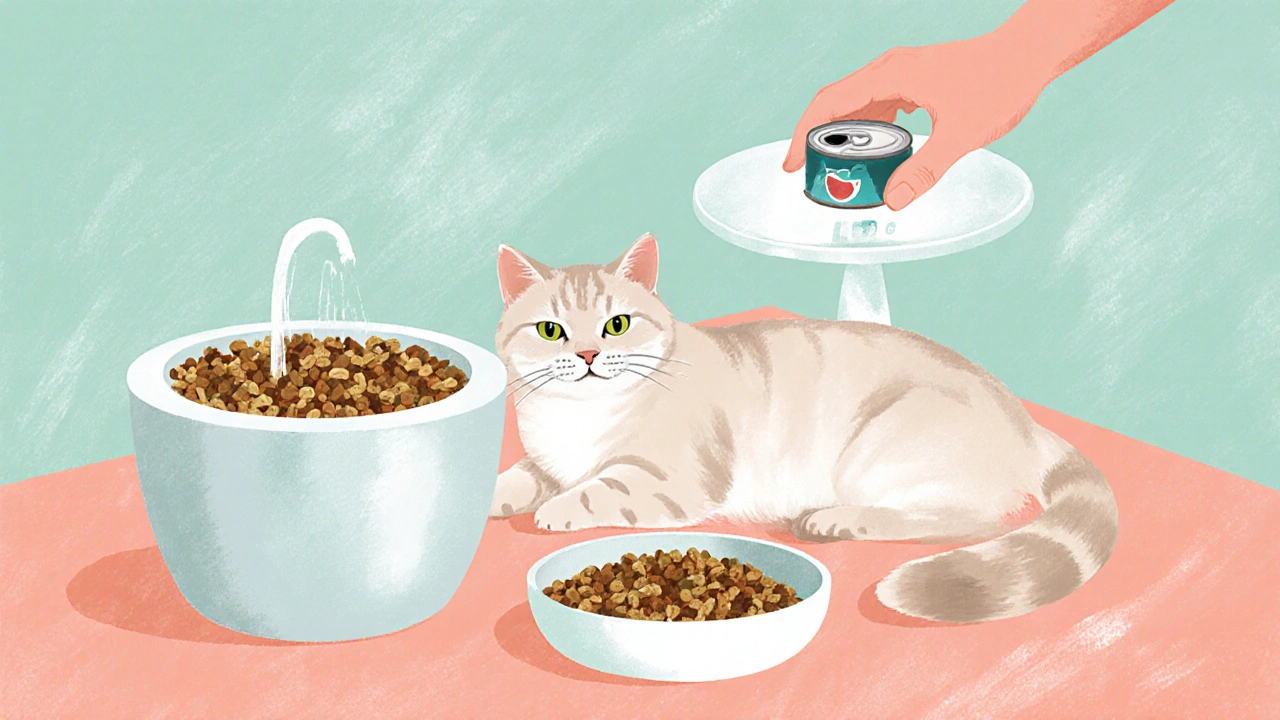
When Wet or Dry Might Be Better for Specific Conditions
Kidney Disease - Cats with compromised kidneys need extra water. Wet food dramatically raises daily fluid intake, reducing strain on the kidneys.
Dental Issues - If your cat has plaque buildup or gingivitis, dry kibble can serve as a mild abrasive. However, dental treats or professional cleanings are more effective.
Obesity - High‑calorie dry kibble can lead to weight gain. Portion control plus a higher proportion of wet food (which is lower in calories per gram) helps manage weight.
Food Allergies - Some cats react to common protein sources. Rotating proteins and using limited‑ingredient wet foods can pinpoint triggers.
Putting It All Together: Sample 7‑Day Meal Plan
Below is a practical schedule for a 4kg adult indoor cat with no known health issues. Adjust portions based on your vet’s advice.
- Day1‑2: Breakfast - ½can (≈60g) wet chicken; Dinner - 40g dry kibble.
- Day3‑4: Breakfast - ½can wet fish; Dinner - 35g dry kibble + 1tsp (≈5g) freeze‑dried meat bites.
- Day5‑6: Breakfast - ¼can wet turkey + ¼can wet liver; Dinner - 30g dry kibble.
- Day7: All‑wet day - Two ½cans (chicken & fish) split between morning and evening.
Track weight weekly; if you see a 1‑2% change, tweak the portions up or down.
Bottom Line: No Absolute Winner, Just a Balanced Approach
Both dry and wet foods can support a thriving cat, but they excel in different areas. Wet food wins for hydration and protein purity, while dry kibble shines in convenience and dental health. The healthiest strategy is usually a blended diet that matches your cat’s life stage, activity level, and any medical needs.
Start with a simple mix, monitor weight and litter habits, and adjust as you go. When in doubt, a quick chat with your vet can fine‑tune the ratios and keep your feline friend purring for years.
Frequently Asked Questions
Can I feed my cat only wet food?
Yes, many cats thrive on an all‑wet diet, especially those prone to urinary problems. Just watch the calories and ensure the wet food meets the minimum protein and taurine levels. Some owners supplement with dental treats to cover the lack of abrasive texture.
Is dry food bad for my cat’s kidneys?
Dry food isn’t directly harmful, but its low moisture can worsen dehydration in cats with kidney disease. Pairing dry kibble with wet meals or a water fountain helps mitigate the risk.
How much wet food should I give per day?
A typical 4kg adult cat needs about 200‑250kcal daily. If the wet food provides 80kcal per 100g, that translates to roughly 250‑300g (one to one‑and‑a‑half cans) split between meals. Adjust based on weight tracking.
Do I need to buy premium brands?
Price isn’t the only indicator of quality. Look for guaranteed analysis: ≥30% protein, ≤10% carbs, and a specified taurine level (≥0.1%). Mid‑range brands that meet these specs can be perfectly healthy.
Can mixing wet and dry cause digestive upset?
Most cats handle a mixed diet well. If you notice soft stools, transition slowly over 7‑10 days and ensure the combined calorie count stays stable.
